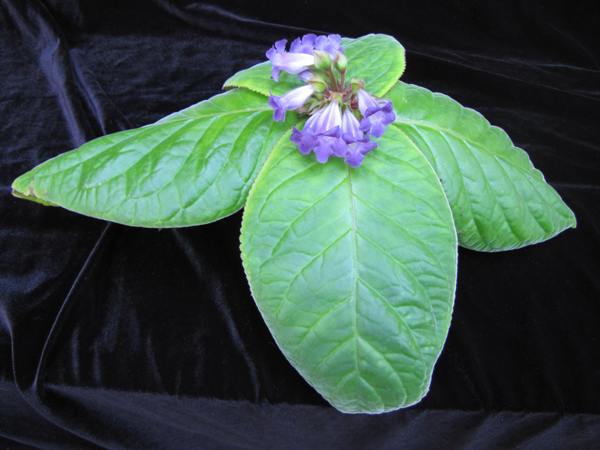
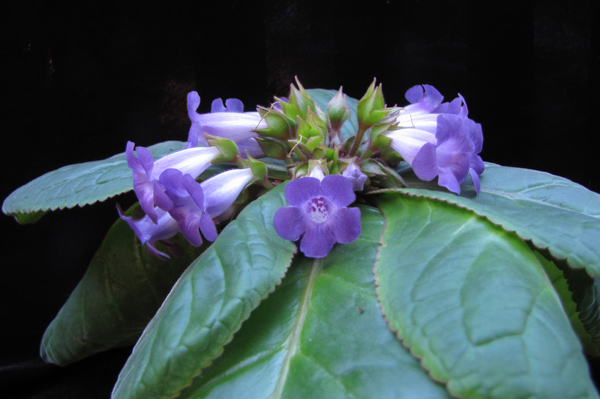
| Species list |
Hybrids list |
Tubers list |
Topics list |
Site index |
What's new |
Home page |

|
|

|
|
|
I grew Sinningia macrophylla from seed distributed by Mauro Peixoto at the 2002 AGGS convention in New Jersey. Although I never got it to bloom, I gave away a number of seedlings, and Brigitte McKnight, one of the excellent growers in the Peninsula Gesneriad Society, obtained very large plants with many flowers, of which I should have gotten a picture, if I actually had a brain cell. In 2008, Karyn Cichocki, who grows so many sinningias well, gave me a small plant of this species at the Denver convention of the Gesneriad Society. In August 2009, it bloomed for the first time, and again in September 2010. Two of the flowers are shown in the photo at the right. The flowers are more magenta than this picture shows. It appears to be hard for cameras to get purples right. Either too much red or not enough. |
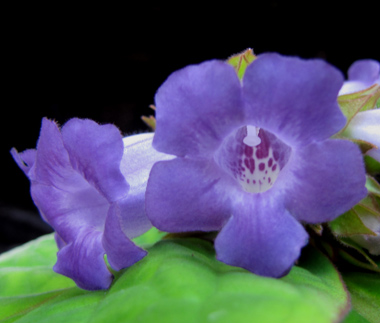
|

|
When grown well, the plant forms a large (12 inches [30 cm] or more across) flat rosette with just a few leaf pairs. The purple flowers resemble those of certain varieties of Sinningia speciosa. According to the DNA data, S. speciosa and S. macrophylla are sister species. The flowers are densely clustered at the center of the plant on short pedicels 2-3 cm [about 1 inch] long. |
Shape
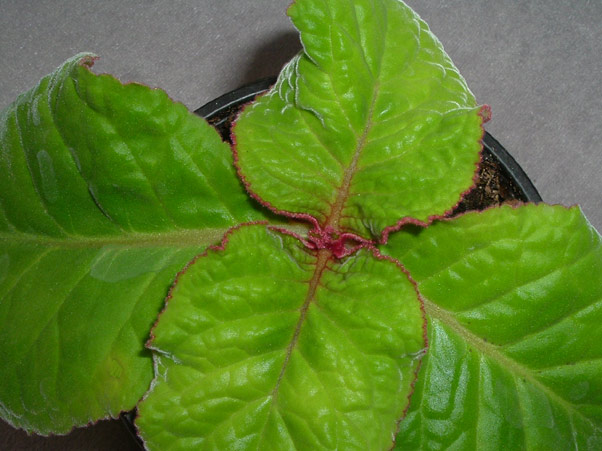
|
|
The picture above shows the plant grown by Karyn Cichocki. Note the flatness of the rosette (even flatter than S. speciosa) and the red fringes on the new leaves and the red color down the midrib of those leaves. There must be a reason for all the red on the tops and bottoms and edges of sinningia leaves, but only Darwin knows it, and he's not telling. |
PropagationI have been able to set seed on my plant. The seeds germinated readily. Although there was a fairly high casualty rate among the young seedlings, the ones which did get established grew well thereafter. When it sprouted in the spring of 2011, the plant put out two shoots. From the pictures, it should be clear that there is no room for more than one shoot in a well-shaped plant, so I removed the smaller one and rooted it. This also seems like a good propagation method. |
Fruit |
||
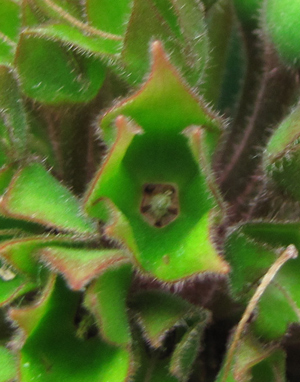
Ovary with clearly visible pentagon of five nectaries. |
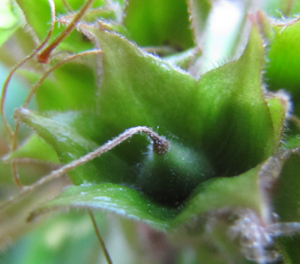
Developing fruit. |
|
|
At the Gesneriad Research Conference in October 2010, Jonathan Ertelt gave a talk on splash cups in the Gesneriaceae. Most sinningia fruits face sideways, with a beak which splits from top to bottom when the fruit is ripe. The seeds are scattered by wind and by animals brushing against the fruit. The splash cup uses a different strategy. It is held like an upward-facing bowl. When it matures, the cover peels back to reveal the seeds. What is then supposed to happen is that a drop of rain lands in the cup and dislodges the seeds, scattering them over nearby ground. Hence the name splash cup. Sinningia macrophylla is one of the few sinningia species with a splash cup, as can be seen in this sequence of pictures. Sinningia barbata is another species with a splash cup. It is in a different clade (or subgroup) of the genus Sinningia, which means that splash cups have evolved independently in different parts of the genus. |
||
| Plant Description |
|
| Growth | Indeterminate |
| Habit | Stems very compressed. Leaves opposite, decussate. |
| Leaves | [see picture above] |
| Dormancy | Has a tuber; goes dormant. |
Flowering |
|
| Inflorescence | Flowers borne in leaf axils, like S. speciosa |
| Season | Mid to late summer. In 2014, this plant had, for the first time, a second crop of flowers in September, after the first crop had faded. |
| Flower | Corolla is campanulate (bell-shaped), with dark purple lobes and a white patch on the bottom of the tube with dark spots. Outside of corolla tube grades from dense purple at the lobes to glossy purple in the middle to white at the base. |
Horticultural aspects |
|
| Hardiness | Probably not frost-tolerant, but I haven't tested it yet. The related S. speciosa does not handle cold well. |
| Propagation | Both rooting side shoots and sowing seed have worked well for me. |
| Multiple crowns? | Unlike S. speciosa, this species has no room for extra crowns. Additional stems usually make the plant very crowded. Removing extra crowns is recommended. |
| Recommended? | Yes, if you have the space for it. The plant is wide but not tall. |
Botany |
|
| Taxonomic group | The speciosa group in the Sinningia clade. |
For some pictures and habitat information, see the page on Mauro Peixoto's web site.
Etymology: macro- ("large") + -phyll ("leaf").
I thought this was a relatively new species, but it was published as Gloxinia macrophylla by Nees and Martius in 1823. In 1894, it was transferred to Sinningia by, um, well, read for yourself:
Sinningia macrophylla (Nees & Mart.) Benth. & Hook.f. ex Fritsch
Okay, here's what I think that means. Alain Chautems explained to me that "AB ex YZ" indicates that AB published the information based on unpublished information from YZ. I gather that "f." after a name abbreviation means "the son" (French fils). Mabberley's Plant Book gives "Hook.f." as Joseph Dalton Hooker (1817-1911), as opposed to "Hook.", which is William Jackson Hooker (1785-1865). And "Benth." is George Bentham (1800-1884).
I call your attention to the fact that the three people mentioned lived 94, 80, and 84 years respectively, in the medically challenged nineteenth century. Botany must be good for you.